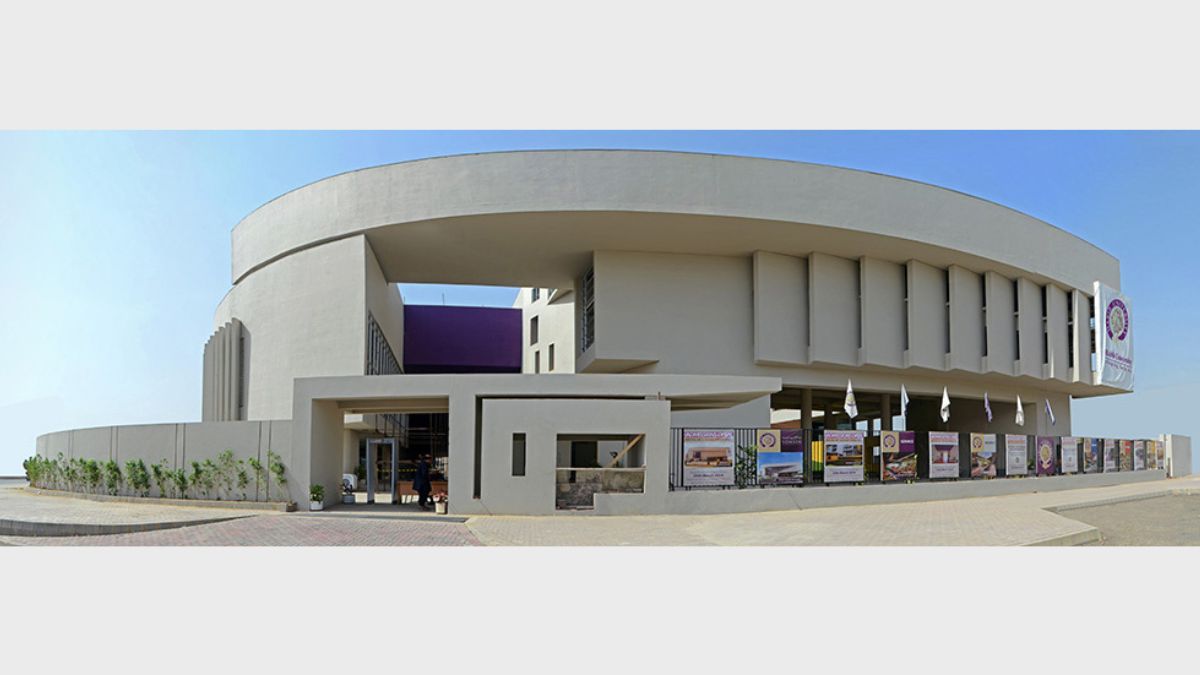TOPIC
10 Best Engineering Universities in Pakistan

Pakistan is home to several prestigious engineering universities, each offering a unique blend of academic excellence, state-of-the-art facilities, and industry-relevant programs. For aspiring engineers, choosing the right institution is crucial for shaping a successful career. In this blog, we explore the 10 best engineering universities in Pakistan that are known for their outstanding education, research capabilities, and commitment to producing industry-ready graduates.
1. Habib University
Located in Karachi, Habib University stands out as a premier liberal arts and science institution that offers a holistic and interdisciplinary approach to education. Its School of Science and Engineering provides a comprehensive curriculum in Electrical and Computer Engineering, focusing on critical thinking, hands-on learning, and innovative problem-solving. Established in 2014, Habib University has quickly gained a reputation for its world-class faculty, modern labs, and advanced research facilities. With a strong emphasis on bridging the gap between theory and practice, Habib University ensures that students are well-prepared to tackle real-world engineering challenges, making it the best university in Pakistan for those looking to excel in this field.
2. National University of Sciences and Technology (NUST)
NUST, located in the capital city of Islamabad, is one of Pakistan’s top-ranked engineering universities. It offers a diverse range of engineering programs including Electrical, Mechanical, and Software Engineering. NUST is recognized for its rigorous academic standards, research-driven approach, and state-of-the-art facilities. It is consistently ranked among the top 400 universities globally, and within the top 100 in Asia, according to QS Rankings. NUST’s School of Electrical Engineering and Computer Sciences (SEECS) is particularly noted for its focus on innovation and technological advancements, making it a popular choice for students aspiring to be at the forefront of the engineering industry.
3. University of Engineering and Technology (UET)
As one of the oldest engineering institutions in Pakistan, UET Lahore has built a strong legacy since its establishment in 1921. Known for its rigorous admission process, UET offers an array of engineering programs, including Electrical, Mechanical, and Civil Engineering. The university places a significant emphasis on research and hands-on training, with well-equipped laboratories and workshops that provide students with the practical skills needed to succeed in their careers. UET’s graduates are highly sought after, thanks to the university’s focus on delivering a strong foundational knowledge in engineering principles combined with practical application.
4. Ghulam Ishaq Khan Institute of Engineering Sciences and Technology (GIKI)
Located in the scenic region of Topi in Khyber Pakhtunkhwa, GIKI is renowned for its commitment to academic excellence and innovation in engineering education. Since its inception in 1993, GIKI has attracted some of the brightest minds in the country due to its selective admission process and challenging curriculum. The university’s programs in Electrical and Mechanical Engineering are highly regarded, with a focus on research, innovation, and entrepreneurship. GIKI’s campus is equipped with modern labs and research facilities, fostering an environment that encourages creativity and problem-solving among its students.
5. Lahore University of Management Sciences (LUMS)
Although LUMS is traditionally known for its business school, it has made significant strides in engineering education through the Syed Babar Ali School of Science and Engineering. The university offers comprehensive programs in Electrical, Mechanical, and Computer Engineering. LUMS distinguishes itself with a strong emphasis on research, entrepreneurship, and interdisciplinary learning. It also offers various scholarships and financial aid programs, such as the National Outreach Program (NOP), which aims to support talented students from underserved regions. LUMS provides a dynamic learning environment that blends theoretical knowledge with practical skills, preparing graduates for leadership roles in their respective fields.
6. Pakistan Institute of Engineering and Applied Sciences (PIEAS)
PIEAS, located in Islamabad, is a premier institution known for its specialized programs in Electrical and Nuclear Engineering. Sponsored by the Pakistan Atomic Energy Commission, PIEAS focuses on high-quality research and development in science and technology. It is consistently ranked among the top 400 universities globally, making it a highly prestigious option for students interested in cutting-edge engineering disciplines. PIEAS’s rigorous academic environment and focus on innovation have made it a leading institution for engineering education in Pakistan.
7. COMSATS University
COMSATS University, with its main campus in Islamabad, offers a variety of engineering degrees including Electrical, Software, and Telecommunications Engineering. The university is known for its modern approach to education, integrating technology and innovation into its curriculum. Ranked among the top 250 universities in Asia, COMSATS has multiple campuses across the country, making quality education accessible to a wide range of students. The university’s emphasis on research and hands-on learning helps graduates excel in their professional careers.
8. FAST National University of Computer and Emerging Sciences
FAST NUCES, primarily known for its strong programs in Computer Science and Software Engineering, also offers competitive degrees in Electrical Engineering. Located in Lahore, FAST focuses on emerging technologies like Artificial Intelligence, Data Science, and Cybersecurity. The university is celebrated for its industry connections, which provide students with valuable internship and job opportunities. Its graduates are known for their technical proficiency and are often recruited by top tech companies in Pakistan and abroad.
9. Information Technology University (ITU)
ITU, situated in the ARFA Software Technology Park in Lahore, is a relatively new but rapidly growing engineering university. It offers innovative programs in Electrical and Computer Engineering with a strong focus on entrepreneurship and industry collaboration. ITU maintains partnerships with prestigious institutions like Harvard University and IBM, providing students with a global perspective. The university’s emphasis on technology, research, and practical skills makes it an attractive choice for students who want to pursue careers in the tech industry.
10. Mehran University of Engineering and Technology (MUET)
MUET, located in the historic city of Jamshoro, Sindh, is one of the top engineering universities in the province. It offers a range of engineering programs including Civil, Mechanical, and Electrical Engineering. The university is known for its strong focus on research, community engagement, and practical training, which helps students develop the skills needed to succeed in a competitive job market. MUET’s alumni network is active across various industries, providing a solid support system for its graduates.
Conclusion
Selecting the right engineering university is a critical step towards achieving your academic and career goals. The 10 best engineering universities in Pakistan listed above offer diverse programs, cutting-edge research facilities, and strong industry connections to help you excel in your chosen field. Whether you prioritize research, hands-on learning, or a vibrant campus life, these institutions provide a strong foundation for future engineers.
TOPIC
Exploring the Legacy of the 6.2mm Jap Aris: A Historical Overview

The 6.2mm Jap Aris is more than just a rifle; it’s a piece of history that echoes through the corridors of time. Known for its distinctive design and rugged reliability, this firearm played a pivotal role during one of the most turbulent periods in modern history—World War II. As we delve into the legacy of the 6.2mm Jap Aris, we’ll uncover its origins, significance on the battlefield, and lasting impact on Japan’s post-war identity. Whether you’re an avid collector or simply intrigued by military history, exploring this iconic weapon offers fascinating insights into both technology and culture during wartime. Join us as we trace the journey of the 6.2mm Jap Aris from its inception to its place in contemporary society.
The Origins of the Jap Aris Rifle
The 6.2mm Jap Aris rifle, known formally as the Type A, has a rich history that dates back to the early 20th century. Developed in Japan during a period of intense militarization, it reflects both innovation and necessity.
The Imperial Japanese Army sought a firearm that could compete with contemporary models from Europe and America. The design was influenced by earlier bolt-action rifles but aimed for improved accuracy and reliability.
Manufactured primarily at the Koishikawa Arsenal, its production began around 1905. Engineers focused on creating a lightweight yet powerful weapon suitable for various combat conditions.
This rifle became standard issue for soldiers during World War II, embodying Japan’s military ambitions at the time. Its unique caliber added to its distinct identity, making it an essential part of Japan’s wartime arsenal.
Historical Significance of the Jap Aris in World War II
The 6.2mm Jap Aris rifle played a crucial role during World War II, primarily serving the Imperial Japanese Army. Its design was rooted in practicality, offering soldiers reliability on the battlefield.
As conflicts escalated across the Pacific Theater, this weapon became synonymous with Japanese military tactics. The Jap Aris showcased both firepower and accuracy, allowing troops to engage effectively at various ranges.
Notably, its influence extended beyond mere combat effectiveness; it represented Japan’s industrial prowess during a time of global turmoil. Each rifle produced symbolized an effort toward modernization against Western powers.
Moreover, the presence of the Jap Aris in key battles emphasized Japan’s commitment to its military strategy. It became integral to numerous engagements, leaving an indelible mark on wartime narratives globally as well as shaping perceptions of Japanese forces among their adversaries.
Famous Battles and Events Involving the Jap Aris
The 6.2mm Jap Aris made its mark in several pivotal battles during World War II. It was a key weapon for Japanese soldiers, showcasing both accuracy and reliability.
One notable engagement was the Battle of Iwo Jima. Fierce fighting unfolded on this small island, with the Jap Aris playing a crucial role in defending strategic positions against American forces. The rugged terrain amplified its effectiveness.
Another significant event was the Philippines Campaign, where the rifle proved indispensable to troops as they faced overwhelming odds. Its presence symbolized determination amid dire circumstances.
In these clashes, the Jap Aris became synonymous with tenacity and resilience. Soldiers relied heavily on it not just for combat but as an emblem of their commitment to duty and country amidst chaos and uncertainty in wartime scenarios.
Impact of the Jap Aris on Post-War Japan
The impact of the 6.2mm Jap Aris on post-war Japan is often overlooked. As the nation rebuilt, this rifle symbolized a complex relationship with its militaristic past.
In the aftermath of World War II, Japan faced significant demilitarization efforts. The Jap Aris became more than just a weapon; it represented a reminder of both devastation and resilience.
Collectors began to emerge, recognizing its historical value rather than merely its functionality as an armament. This sparked interest in military memorabilia across generations.
Military surplus stores filled with these rifles attracted enthusiasts eager to connect with history. Events like gun shows further fueled discussions about Japan’s wartime legacy.
As time passed, the Jap Aris transitioned from a tool of war to an artifact cherished by historians and collectors alike. Its presence shaped narratives around peace and remembrance in contemporary Japanese society.
Modern Collectors and Enthusiasts of the Jap Aris
In recent years, the 6.2mm Jap Aris has gained traction among modern collectors and enthusiasts. Its unique design and historical significance make it a sought-after piece for many.
Collectors appreciate the craftsmanship of these rifles. The intricate details reflect an era that shaped military history. Some focus on acquiring different models or variations, while others seek pristine examples to display.
Online communities have blossomed around this interest. Forums and social media groups connect enthusiasts from all over the world. They share insights, restoration tips, and even host virtual shows.
Events like gun shows often feature the Jap Aris prominently. Here, collectors can trade stories and showcase their prized possessions alongside other historic firearms.
The appeal lies not just in ownership but also in preservation of heritage. For many, owning a Jap Aris is about honoring its legacy as much as it is about collection itself.
Conclusion: The Enduring Legacy of the 6
The 6.2mm Jap Aris stands as a significant piece of military history, embodying both the technological advancements and the strategic imperatives of its time. Its design reflects the ingenuity and resourcefulness prevalent during an era marked by conflict.
As we explore its journey from conception to battlefield prominence, it becomes evident how much this rifle influenced warfare tactics in World War II. The stories surrounding famous battles highlight not just its effectiveness but also the resilience of those who wielded it.
Beyond the war front, the legacy of the Jap Aris continues to resonate today. Collectors and enthusiasts cherish these rifles for their historical value, ensuring that future generations appreciate their role in shaping modern firearms technology.
The enduring fascination with the 6.2mm Jap Aris is more than just about collecting; it’s about understanding a pivotal moment in history through a tangible artifact that connects us to our past. This rifle remains a symbol of innovation amid adversity, carrying forward lessons learned on battlefields around the world.
TOPIC
Lessons from Rekisha Duckworth: Leadership, Resilience, and Passion

Rekisha Duckworth is a name that resonates with inspiration and determination. Her journey through life’s challenges showcases the essence of leadership, resilience, and an unwavering passion for empowering others. From humble beginnings to becoming a prominent leader in her field, Rekisha’s story is not just about personal success; it’s about uplifting those around her. As we delve deeper into her life and principles, we uncover valuable lessons that can guide anyone on their path to greatness. Let’s explore the remarkable experiences that shape Rekisha Duckworth’s legacy and discover what makes her an extraordinary role model in today’s world.
Early Life and Career Journey
Rekisha Duckworth’s journey began in a small town, where her roots shaped her ambitions. Growing up in a tight-knit community taught her the value of hard work and determination.
From an early age, she excelled academically. Her curiosity about the world around her pushed her to seek knowledge beyond textbooks. This thirst for learning laid the foundation for future success.
After completing high school, Rekisha pursued higher education with vigor. She juggled multiple jobs while studying, showcasing her dedication and resilience. Each challenge became a stepping stone rather than a setback.
Entering the corporate world was both exciting and daunting. Rekisha quickly realized that navigating this landscape required more than just talent; it demanded leadership skills and emotional intelligence. Early experiences taught her valuable lessons that would define her career trajectory.
Leadership Principles Demonstrated by Rekisha
Rekisha Duckworth exemplifies powerful leadership through her inclusive approach. She believes in bringing diverse voices to the table, ensuring everyone feels valued. This practice not only fosters collaboration but also sparks innovation.
Her transparency sets a strong foundation for trust within her team. By openly sharing challenges and successes, she creates an environment where vulnerability is embraced rather than feared.
Moreover, Rekisha leads by example. Her work ethic inspires those around her to strive for excellence while maintaining integrity. She understands that real leadership involves uplifting others.
Adaptability is another hallmark of her style. In an ever-changing landscape, Rekisha remains flexible and encourages her team to embrace change as an opportunity for growth rather than a setback.
Through these principles, she cultivates leaders within her organization who are empowered to make decisions and drive impactful results.
Overcoming Adversity: The Power of Resilience
Rekisha Duckworth’s journey is a testament to the incredible strength of resilience. Life often throws unexpected challenges our way, and Rekisha faced her share with unwavering determination.
When obstacles seemed insurmountable, she chose to push through rather than give up. This mindset transformed difficulties into stepping stones for growth. Each setback became an opportunity to learn and adapt.
Resilience isn’t just about bouncing back; it’s about evolving stronger. Rekisha embraced this philosophy wholeheartedly. She turned struggles into fuel for her ambition.
Her story illustrates that setbacks are not the end but merely pauses in life’s narrative. With each challenge overcome, Rekisha inspired those around her to adopt a similar approach towards adversity. The power of resilience lies in belief—believing that you can rise above circumstances, no matter how tough they may seem.
This lesson resonates deeply in both personal and professional realms, encouraging everyone to harness their inner strength when facing life’s trials.
Passion for Empowering Others
Rekisha Duckworth embodies a profound passion for empowering others. Her journey has been marked by an unwavering commitment to lift those around her, especially marginalized voices.
She believes in the potential of every individual. This belief drives her initiatives aimed at mentorship and community engagement. By sharing her knowledge and experiences, she cultivates an environment where others can thrive.
In workshops and seminars, Rekisha emphasizes the importance of skill-building and self-advocacy. She encourages participants to discover their strengths, fostering confidence that radiates beyond the classroom.
Her approach is hands-on; she leads by example. Whether through volunteering or speaking engagements, Rekisha dedicates time to connect with people from diverse backgrounds.
This dedication not only transforms lives but also creates ripples of positive change within communities. Through her efforts, many have found their voice and purpose in life’s myriad challenges.
Lessons Learned from Rekisha’s Story
Rekisha Duckworth’s journey offers valuable lessons for anyone seeking growth. Her resilience in the face of challenges is a testament to the strength we all possess within.
She teaches us that setbacks are not failures but opportunities for learning and development. Embracing adversity can lead to personal transformation.
Moreover, her leadership style emphasizes empathy and collaboration. By prioritizing genuine connections with her team, she cultivates an environment where everyone feels valued.
Passion shines through Rekisha’s work, reminding us that pursuing what you love can inspire others along the way. It’s about igniting a spark in those around you.
Her story encourages us to take risks. Stepping outside our comfort zones often leads to unexpected rewards and experiences worth cherishing.
Each lesson from Rekisha reflects how authenticity and determination pave the path toward success, urging us all to tap into our potential without hesitation.
Conclusion
Rekisha Duckworth’s journey is a powerful testament to what can be achieved through leadership, resilience, and an unwavering passion for empowering others. Her early life shaped her values and commitment to making a difference. The principles she embodies serve as a guiding light for aspiring leaders everywhere.
Facing adversity head-on has not only fortified Rekisha’s character but also inspired many around her. She demonstrates that challenges can be transformative opportunities when met with determination and strength.
Her dedication to uplifting others showcases the importance of community and support in personal and professional growth. Rekisha reminds us all that success is not solely about individual achievement; it’s about lifting those around you.
The lessons gleaned from her story are invaluable for anyone looking to navigate their own path in life or leadership roles. Embracing resilience, practicing genuine leadership, and fostering a spirit of empowerment will create profound impacts on individuals and communities alike.
Rekisha Duckworth’s legacy encourages us all to take action towards our goals while supporting each other along the way—an essential reminder in today’s world where collaboration truly leads to greatness.
TOPIC
The Dark Side of Care: Investigating Zola Hospice Fraud Claims

Zola Hospice Fraud has recently come under scrutiny due to serious allegations. Families have claimed that the organization billed for services never rendered, leaving grieving relatives confused and outraged.
Reports surfaced suggesting a pattern of overcharging for medications and equipment. Many patients did not receive the level of care promised in their marketing materials. This discrepancy raises significant ethical questions about how hospice providers operate.
Some families discovered they were charged for unnecessary treatments, which only added to their emotional burden during already difficult times. The supposed mismanagement of resources is alarming, especially in an industry where trust is paramount.
These claims highlight a troubling reality within some hospice organizations, sparking discussions on accountability and transparency. As investigations unfold, affected families are left seeking answers amid the chaos surrounding Zola Hospice’s practices.
Scams and Manipulation Tactics Used by Zola Hospice
Reports suggest that Zola Hospice has employed various scams and manipulation tactics to exploit vulnerable patients and their families. Some caregivers allegedly pressure families into signing documents without fully understanding the implications.
These tactics often include emotional appeals, where staff members may invoke guilt or fear to secure consent for services that aren’t necessary. Families seeking comfort during difficult times can feel overwhelmed, making them more susceptible to persuasive language.
Furthermore, there are claims of inflating service costs or charging for items not provided at all. This deceptive billing practice raises significant ethical concerns within the hospice care industry.
Manipulation isn’t just limited to financial aspects; some reports indicate a lack of transparency regarding patient care plans, leaving family members in the dark about what services are being offered—or even needed—by their loved ones. Such actions deeply undermine trust in a system meant to provide compassion and support during life’s most challenging moments.
Patient Interviews and Personal Experiences with Zola Hospice Fraud
Patients and their families have shared deeply personal experiences with Zola Hospice Fraud, painting a varied picture of care. Some spoke highly of the compassionate staff who provided comfort during difficult times. They emphasized how nurses went above and beyond to ensure their loved ones felt dignified and cared for.
However, contrasting stories also emerged. Several families reported feeling pressured into making decisions that benefited the hospice rather than focusing on patient needs. One individual described receiving an unexpected bill after assurances about coverage—an unsettling surprise during such a vulnerable period.
Interviews reveal anxiety among patients regarding transparency in treatment plans. Many voiced concerns over communication barriers, leaving them unsure about what services were genuinely necessary versus those potentially inflated for profit motives. These conflicting narratives highlight the complexity surrounding Zola Hospice’s reputation in the community and raise critical questions about trust in end-of-life care providers.
Legal Action Taken Against Zola Hospice
Legal action has emerged as a significant response to the allegations surrounding Zola Hospice. Families impacted by the alleged fraud have taken steps to seek justice. Lawsuits claim that the hospice exploited vulnerable patients for financial gain.
In some cases, whistleblowers within the organization provided critical evidence. Their testimonies revealed alarming practices that contradicted ethical care standards. Many believe these actions warrant immediate legal scrutiny.
Regulatory bodies are now investigating these claims further. They aim to determine if Zola Hospice violated any state or federal laws in their operations. The attention from legal authorities may lead to stricter oversight of similar facilities.
Additionally, victims and their families advocate for more transparency in healthcare practices. Their voices highlight a growing demand for accountability within hospice care services across the nation.
Lack of Regulations in the Hospice Industry
The hospice industry has long been criticized for its lack of stringent regulations. This gap allows some organizations to operate without adequate oversight. As a result, vulnerable patients and their families can fall prey to unethical practices.
Many hospices navigate through ambiguous guidelines, which can lead to inconsistent care standards. These discrepancies create an environment where fraud may flourish unnoticed.
With minimal checks in place, it becomes challenging for families to discern trustworthy providers from those with ulterior motives. The complexity of healthcare regulations often leaves consumers feeling overwhelmed and uncertain.
As these troubling realities come to light, calls for reform grow louder. Advocates emphasize the need for comprehensive policies that safeguard patients’ rights and ensure quality care across the board. The current landscape highlights a pressing issue in our healthcare system that cannot be ignored.
Steps to Protect Yourself and Your Loved Ones from Potential Fraud in Hospice Care
When navigating hospice care, awareness is crucial. Start by researching facilities and services thoroughly. Look for reviews and testimonials from other families.
Ask detailed questions about the care plans offered. Understand what is covered under insurance and how billing practices work. Transparency is key.
Be vigilant about any changes in your loved one’s treatment or medication regimen. If something feels off, don’t hesitate to seek clarification.
Involve multiple family members in discussions with hospice staff to ensure different perspectives are considered. This collective approach can help uncover inconsistencies.
Stay informed about your rights as a patient or caregiver. Familiarize yourself with local regulations regarding hospice care to empower you against potential fraud schemes that may arise within this vulnerable sector of healthcare.
Conclusion: Importance of Proper Oversight
The hospice care industry is a crucial component of healthcare that supports patients and their families during some of life’s most challenging times. However, as the allegations against Zola Hospice Fraud reveal, not all providers maintain the ethics and integrity necessary to deliver compassionate care.
The claims of fraud highlight a pressing need for oversight within this sector. Families deserve to feel safe and supported when seeking end-of-life care for their loved ones. Ensuring that proper regulations are in place can help prevent manipulation tactics from taking root.
It is essential for both individuals and regulatory bodies to remain vigilant about potential fraud in hospice services. By demanding accountability from providers like Zola Hospice Fraud, we can work toward an environment where genuine compassion triumphs over exploitation, allowing families peace during what should be a sacred journey.
-

 TOPIC1 week ago
TOPIC1 week agoIs Checwifeswap Right for You? Pros and Cons Explained
-

 TOPIC1 month ago
TOPIC1 month agoThe Significance of 17029009482: An In-Depth Exploration
-

 TOPIC1 week ago
TOPIC1 week agoWhy Magdalenavuk15 is Making Waves in the Blogging Community
-

 TOPIC1 month ago
TOPIC1 month agoTop Features of the Denso 10PA17 447220-4771 You Should Know
-

 TOPIC1 month ago
TOPIC1 month agoTinkerdinky: A Playful Approach to Innovation and Design
-

 TOPIC2 weeks ago
TOPIC2 weeks agoThe Evolution of ICS15014849: What You Need to Know
-

 HEALTH1 month ago
HEALTH1 month agoThe Benefits and Risks of Emervuy Surgery Explained
-

 TOPIC4 weeks ago
TOPIC4 weeks agoTronics Orul1108: Revolutionizing Your Tech Experience
